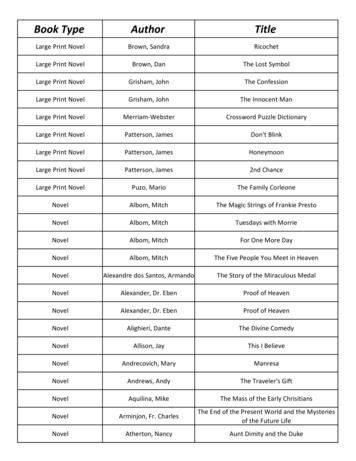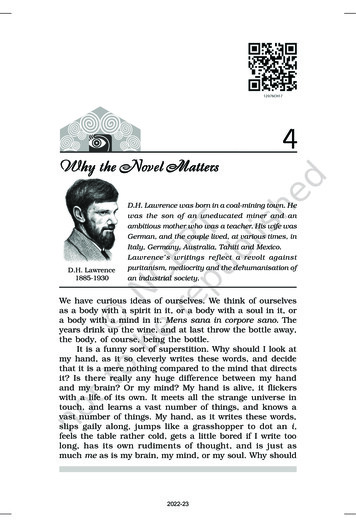
Transcription
Conference on Information Systems Applied ResearchNashville Tennessee, USA2010 CONISAR Proceedingsv3 n1520NATIS: Novel Architecture Framework forAlgorithmic Trading Information Systems-- Automated Stock Trading via ElectronicCommunication NetworksSamuel Sambasivam, Ph.D.ssambasivam@apu.eduSheldon Liang, Ph.D.sliang@apu.eduComputer Science DepartmentAzusa Pacific UniversityAzusa, CA 91702Roger Liaorliao@ix.netcom.comYootech Associates LLCAbstractComputer Information Systems (CIS) are broadly applied to many areas via internetworking computers. Among them Algorithmic Trading via Electronic Communication Networks (ECN) representsa new direction toward which CIS is applied to the stock exchange in an automated way. This paper presents a Novel Architecture Framework for Algorithmic Trading Information Systems (NATIS)with emphasis on its scalability, flexibility, and generality for Algorithmic Trading (information) systems via ECN with emphasis on such views as strategic view (activities through cognitive processesof decision-making), managerial view (activities to accomplish desired goals), and operational view(activities to produce profit) in order to support sound features: scalability, flexibility, and generality. A case study is also given to specify how NATIS flexibly accommodates Day Trading Businessthrough strategic, managerial and operational activities in an automated way. As a result, flexiblyconstructing automated stock trading is made not only feasible via ECN, but also possible whentrading strategies need to alter to take advantage of various situations.Keywords: AST: Algorithmic Stock Trading, ECN: Electronic Communication Network, TAFIM:Technical Architectural Framework for Information Management.1. INTRODUCTIONToday, Computer Information Systems arebroadly applied to many areas, including Algorithmic Trading via Electronic CommunicationNetworks, or ECN for short, which are automated order matching systems. An Information System (IS) is any combination of infor-mation technology and people using this technology to support operations, management,and decision-making (SEI Report). This kindof mission-specific computer information systems involves many computational activities,such as the gathering, processing, storage,distribution and use of information via inter- 2010 EDSIG (Education Special Interest Group of the AITP)www.aitp-edsig.org /proc.conisar.orgPage 1
Conference on Information Systems Applied ResearchNashville Tennessee, USAnetworking computers. These activities aretypically categorized as: strategic -- decisionmaking through a cognitive process that results in the selection of a course of actionamong several alternatives, managerial -assembling parties (referring to data, information, and knowledge) together to accomplishdesired goals and operational -- ongoing recurring activities involved in the running of abusiness for the purpose of producing profit.In electronic financial markets, algorithmictrading or automated trading is the use ofcomputer programs to enter trading orderswith the computer algorithm deciding on characteristic of the order such as the timing,price, or quantity of the order and in manycases initiating the order without human intervention. Obviously, algorithmic trading via ECNrepresents a new direction toward which Computer Information System(s) is applied in anautomated way. For instance, an example ofalgorithmic trading or automated trading is if aday trading request to buy or sell a stock orsecurity is sent into ECN, the trading platformbehind ECN automatically matches the orderwith an opposite order (i.e. a sell if it’s a buy,or a buy if it’s a sell) of the same size for riskmanagement purposes. Advantageously, for aliquid stock, an ECN can manage this in asecond or less drastically reducing the probability for a high loss.2010 CONISAR Proceedingsv3 n1520The Technical Architecture Framework for Information Management (TAFIM-DoD) providesenterprise-level guidance for the evolution ofthe DoD Technical infrastructure. It also identifies the services, standards, concepts, components, and configurations that can be used toguide the development of technical architectures that meet specific mission requirements.The entire enterprise, as previously defined,includes Work Organization, Information, Application, and Technology. This leads to thefour different views:Figure 1. Technical Architectural FrameworkAlgorithmic trading via ECN, regarded as a typfor Information Managementical computer information system, involvesinformation technology, and human interaction Work Organization View: The work view ofarchitecture is developed by identifying specificwith this technology, to support operations,classes of users within the business environmanagement, and decision-making. In a veryment, business location. This is the logical rebroad sense, the term information system ispresentation of the business functions that arefrequently used to refer to the interaction berequired to deliver products and services.tween people, algorithmic processes, data andtechnology. In this sense, the term is used to Information Management View: The informarefer not only to the information and communition architecture of the enterprise will containcation technology (ICT) an organization uses,three levels of detail; subject areas, databut also to the way in which people interactgroups, and data attributes.with this technology in support of business Application View: This view focuses on theprocesses.opportunities to automate aspects of work andAFIM: A Reference Architecture Modelor the access to information needed to performIn order to effectively incorporate informationwork.(source data, intelligence), algorithmic process(business application), and communication Technology Infrastructure View: This area oftechnology into computer information systems,architecture uses specific component-levelTAFIM provides us a great reference model tomodels to provide the basis for linking thereflect mission-specific software architecture,technology view of the architecture to thedata structures (architecture), and communiwork, information, and application views.cation infrastructure, shown as Figure 1. 2010 EDSIG (Education Special Interest Group of the AITP)www.aitp-edsig.org /proc.conisar.orgPage 2
Conference on Information Systems Applied ResearchNashville Tennessee, USA2010 CONISAR Proceedingsv3 n1520TAFIM, recommended by the US DoD as a reference model for enterprise architecture development, defines a target common conceptualframework, an information system infrastructure. However the architecture and associatedmodel, is NOT a specific system design. Rather, it establishes a common vocabulary anddefines a set of services and interfaces common to information systems.functional flexibility, and managerial view withfocus on informative generality. Section 3 discusses a case study of algorithmic trading system from manual operation to algorithmic automation. And section 4 draws a conclusion ofhow the NATIS would work as well as futurework.NATIS: A Novel Architecture ModelThe ideal adaption of TAFIM to NATIS (novelarchitecture framework for algorithmic tradinginformation systems) is developed with emphasis on strategic computation through cognitive process, in which the decision-making mechanism should be very flexible to adjust trading strategies with great ease (Altucher, 2004).Comparatively and relatively, operational activities, embodied as input-process-output paradigm as well as information management, aresophisticatedly stable without dramatic changefrom application to application.While TAFIM represents a good start, we willhave to help it “streamline” to be adapted to anovel architecture model for algorithmic trading with emphasis on either adjustable strategic aspects or functional flexibility. Three viewsfor NATIS are developed with specific considerations in the algorithmic trading applicationarea:As well known, systematic scalability (whatallows a system to continue to function wellwhen its context is changed in size) and informative generality (what parameterizes datatype to a generic extent in order for information management to be done in a unified way)are fundamentals of constructing complex information systems, in which we have alreadyachieved sound accomplishments in our previous work (De Lemos, 2004; Liang, 2003a;Liang, 2003b). In constructing algorithmictrading systems, functional flexibility plays acentral role in accommodating changes, automating the decision-making process, and automating aspects of work and or the access toinformation needed to perform work, so we willput our focus on discussing strategic aspectsabout algorithmic trading through functionalflexibility.The main contribution is the adaption of TAFIMto a novel architecture framework for algorithmic trading information systems with threeviews specified with respect to systematic scalability, functional flexibility, and informativegenerality.This paper has three sections. Section 2presents a novel architecture framework andthoroughly discusses three views for an algorithmic trading information system:operational view in support of systematic scalability,strategic view developed to accommodate2. NOVEL ARCHITECTURE OVERVIEWOperational view is used to describe thetasks and activities, operational elements, andinformation exchanges required to conduct operations. Furthermore, operations and theirrelationships may be influenced by new technologies such as collaboration technology,where process improvements are in practicebefore policy can reflect the new procedures(Liang & Sambasivam, 2010; Liang, 2008).With the support of ECN, systematic nts the ability of adding new processingmodules into the system with ease, since analgorithmic trading system usually does not actas a standalone application, but appears as anode on the basis of input-process-output paradigm.Strategic view describes the unique parts ofsystematic behavior, its activities, and howthose activities contribute to success. It alsocreates options or alternative solution againstthe mission by re-organizing particular functions composed from strategic elements (Liang& Sambasivam, 2009). In other words, thecognitive process that reflects human strategies and intelligence is applied to stock tradingwith or without human intervention. Central tothe strategic view is the ability to accommodate strategy adjustment, and operational options that automated trading can be done inalternative ways.Managerial view defines how to organize various entities and attributes into a bounded setor system, in order for the outcomes can becontrolled. In other words, we can manage,manipulate, and measure information to 2010 EDSIG (Education Special Interest Group of the AITP)www.aitp-edsig.org /proc.conisar.orgPage 3
Conference on Information Systems Applied ResearchNashville Tennessee, USAachieve control within the limits of our system(Liang & Sambasivam, 2009; Liang, 2003).Since all information communication dominatesinput / output (to or from the system), general information management plays an irreplaceable role in flexibly constructing algorithmic trading (information) systems.Figure 5 illustrates that NATIS places the algorithmic trading system under a networking environment as both input node into the networkand output node from the network. Strategicview in the trading environment plays the central part in accommodating, adjusting, andstimulating all activities to work in a highlycoordinated way. Obviously, the algorithmictrading system acts as a componential system,under a system of systems environment, andis internetworked with other automated trading platforms. Later on we will see that ECN supports interconnection between such kinds ofcomponential systems though API provided byvendors of trading platforms, such asLightspeed (Automated Trading), Sterling (Trading Platforms) etc. Conceptually, func- tional flexibility is derived through strategicview, systematic scalability through operationalview, and informative generality through managerial view, which will be discussed thoroughly in the next section.Operational View: Systematic ScalabilityOperational View for the NATIS describes thetasks and activities, operational elements, andinformation exchanges required to conduct operations. All the products and services are delivered through information communication with or without human intervention (manually or fully automated). A pure Operational View ismaterial independent. However, operationsand their relationships may be influenced bynew technologies such as collaboration tech nology, where process improvements are inpractice before policy can reflect the new procedures. With or without human intervention(manually or fully automated). Operationalactivities embody systematic scalability in aninput-process-output paradigm, which meansthe NATIS usually does not acts as a standalone application, but appears as inputs andoutputs that bring about mission-specific functionality.Figure 6 illustrates the NATIS’s OperationalView that emphasizes systematic scalability.Differing from TAFIM, with the support of ECN,operational view in NATIS stresses Information2010 CONISAR Proceedingsv3 n1520Interchange, Human Computer Interaction,and Networking Interoperation between /among componential systems.Systematic Scalability is the ability of an application to continue to function well when it (orits context) has changed in size or volume inorder to meet the user’s needs. Typically, therescaling is to a larger size or volume. The rescaling can be of the product itself (for example,a line of computer systems of different sizes interms of storage, RAM, and so forth) or in thescalable object's movement to a new context(for example, a new operating system). In ourNATIS model, the central to the system scalability is embodied by I3 capabilities: Networking Interoperation, Information Interchange,and Human Computer Interaction.Networking Interoperation or interoperabilityrefers to both capability to interchange information between diverse components, and theability for joint task execution over-thenetwork (Liang, 2008; Young et.al, 2001).Information Interchange or the exchange ofinformation among applications shall be basedon the logical data models developed as theresult of identifying information requirementsthrough activity or process models. The standard data elements shall be exchanged usingthe data management and data interchangeservices of application platforms. The intent isto exchange information directly between information systems without the constraint offormatted messages, subject to security classification considerations (Data Exchange).Human Computer Interaction focuses oninteraction and specifically on interaction between one or more humans and one or morecomputational machines (HCI).Significantly, NATIS supports algorithmic trading business in a scalable approach. In electronic financial markets, algorithmic tradingis the use of computer programs for enteringtrading orders with the computer algorithmdeciding on aspects of the order such as thetiming, price, or quantity of the order, or inmany cases initiating the order without humanintervention. An electronic communicationnetwork (ECN) is the term used in financialcircles for a type of computer system that facilitates trading of financial products outside ofstock exchanges. That is to say, ECN is anelectronic system that attempts to eliminatethe role of a third party in the execution of or- 2010 EDSIG (Education Special Interest Group of the AITP)www.aitp-edsig.org /proc.conisar.orgPage 4
Conference on Information Systems Applied ResearchNashville Tennessee, USAders entered by an exchange market maker oran over-the-counter market maker, and permits such orders to be entirely or partly executed (ECN).Strategic View: Functional FlexibilityStrategic View for the NATIS describes theunique parts of systematic behavior, all activities, and how those activities contribute to thesuccess.Strategic activities accommodatefunctional flexibility that acts like the brain tothe algorithmic trading systems to create options or alternative solutions against the mission by re-organizing particular functions composed from strategic elements (Liang & Sambasivam, 2009).Mission-specific functionalrequirements in trading business, in terms oftrading strategy, change from time to time,which is why we stress the flexibility thatmakes trading strategies adjustable throughstrategic elements in order to form particularfunctions.Figure 2 illustrates the NATIS’ Strategic Viewthat emphasizes functional flexibility with themission in “mind” that can split up into recompostable objectives and measurable goals.Acting as the brain to the algorithmic tradingbusiness, strategic view in NATIS stresses accommodation to trading business (reflectingspecific mission), automation of cognitiveprocess (adjustable objectives and decisionmaking), and adjustment against strategychanges (embodied as measurable goals). Withrespect to Knowledgebase, it actually comesfrom Managerial View through data analysis,data mining, and data manipulation.Figure 2. NATIS Functional Flexibility fromStrategic View via Knowledgebase2010 CONISAR Proceedingsv3 n1520response to different strategies and systemrequirements. Generally, stock trading is likeplaying a chess game, a strategy is proved tobe effective in a certain circumstance, butwon’t be working under another situation. Inother words, functional flexibility allows adjustable objectives to be reflected by particularfunctions and enables measurable goals to becomputerized to fulfill the mission (businesspurpose) through alternative solutions bycreating different options. In our NATIS model,the central objective of the functional flexibilityis embodied by A3 capabilities: Accommodation to trading purpose, Automation of cognitive process, and Adjustment against strategychanges. Accommodation to business purpose refers tomission’s fulfillment in alternative approach.In the trading process, high probability of winis the priority, but we may have different approach toward the direction. Automation of cognitive process or decisionmaking of application shall be based on thecapability of reorganization of particular functions that certain objectives can be reached.Furthermore, the re-organized objectives become the key to the fulfillment of the mission(business purpose). Adjustment against strategic rules or elementsfocuses on quantitative strategic and / orknowledgeable elements (or rules) that theparticular functions can be adjusted. In a programmable sense, this works like parameterization of functions.Obviously, the mission-specific application’spurpose is fulfilled through objectives withmeasurable goals. NATIS supports algorithmictrading by means of flexible-adjustment of thestrategies and functionality. In reality, successful trading strategies work effectively inmost cases, but if all the traders use the samestrategy, the result would be negative for everyone. Therefore, there must exist a way forthe trading expert to adjust the strategieswhen necessary. Although all the trading activities have the same mission or purpose ofproducing profit, objectives and goals need tobe adjustable so that an alternative approaches can be used to fulfill the mission (Stocktrading Strategy, Trading Markets, and Trending)Functional Flexibility is the ability of computerbased information systems to change easily in 2010 EDSIG (Education Special Interest Group of the AITP)www.aitp-edsig.org /proc.conisar.orgPage 5
Conference on Information Systems Applied ResearchNashville Tennessee, USA2010 CONISAR Proceedingsv3 n1520concept); templates in C ; and parameterized types in the influential 1994 book DesignPatterns. The authors of Design Patterns notethat this technique, especially when combinedwith delegation, is very powerful but that "Dynamic, highly parameterized software is harderto understand than more static software."(Gang of Four 1995:21).Figure 3. NATIS Informative Generality fromManagerial View via DatabaseManagerial View: Informative GeneralityManagerial View for the NATIS defines how toorganize various entities and attributes into abounded set or system, so that the outcomescan be controlled. In other words, from theviewpoint of management, an algorithmic trading information system is seen as an organization for control. Under this organization withmany entities and attributes well managed, wecan manage, manipulate, and measure information to achieve control within the limits ofour system (Liang & Sambasivam, 2009). Managerial activities concern Informative generality which means all algorithms used for management, manipulation, and measurement aregeneralized that they can be instantiated when needed for specific types of data, information,or knowledge provided as parameters.Figure 3 illustrates the NATIS’ Managerial Viewthat emphasizes informative generality via parameterization that database / information details can be hidden from the outside. An important measure of the success of an ISand architecture is its ability to adapt tochanging circumstances through informationhiding and interchange. Generic programmingis a style of computer programming in whichalgorithms are written in terms of to-bespecified-later types that are then instantiatedwhen needed for specific types provided as parameters. This approach, pioneered by Adain 1983, permits writing common functions ortypes that differ only in the set of types onwhich they operate when used, thus reducingduplication. Software entities created usinggeneric programming are known as generics inAda, Eiffel, Java, C#, and Visual Basic .NET;parametric polymorphism in ML and Haskell(the Haskell community also uses the term"generic" for a related but somewhat differentInformative Generality refers to features ofcertain statically typed programming languages that allow some code to effectively refinethe static type system. For instance in C , atemplate is a routine in which some parameters are qualified by a type variable. Sincecode generation in C depends on concretetypes, the template is specialized for eachcombination of argument types that occur atsome instantiation. Generic programming iscommonly used to implement containers suchas lists and hash tables and functions such as aparticular sorting algorithm for objects specified in terms more general than a concretetype. In our NATIS model, the central to theinformative generality is embodied by M3 capabilities:management, manipulability, andmeasurement of information and data storedas trading knowledge, strategic intelligence indatabase.Information Management is the ability tocollect and manage information from one ormore sources and the distribution of that information to one or more audiences. This doesa great favor in support of information interchange through operational view.Data Manipulation is the ability to process datato form useful information assists in the decision making process. Data manipulation language defines the interface between a database and an applications program, which isembedded in the language of the applicationsprogram and provides the programmer withprocedures for accessing data in the data base.Knowledge Measurement organizes knowledgerepresentation to the quantitative extent thatthe application can measure, statistically analyze information for decision making, whichdoes a great favor in support of strategic accommodation to functional flexibility.The "Golden Rule of Data Manipulation" is asimple but important rule that should alwaysbe followed when designing a database, writing 2010 EDSIG (Education Special Interest Group of the AITP)www.aitp-edsig.org /proc.conisar.orgPage 6
Conference on Information Systems Applied ResearchNashville Tennessee, USAdatabase code, or writing any application codeat all for that matter:"It is always easier and more flexible to combine data elements rather than to break themapart"Informative generality establishes the firmfoundation in support algorithmic trading viaElectronic Communication Networks. WithoutInformative Generality, it would be really hardto fulfill networking interoperation, informationinterchange, and human computer interaction.3. CASE STUDY: STAR TRADING SYSTEMSAT YOOTECHBefore discussing the case study, we need tointroduce a bit trading principle. The tradingchart represents price and trends for stocktrading. When the curve goes down, it indicates a good chance to sell your stock; whenthe curve goes up, it indicates a chance to buy.So an Algorithmic Trading Information Systemis supposed to process the data from market(live data: NYSE or Nasdaq), predict the trendsand act with order positions (submit BUY/SELLorder via ECN), shown as Figure 4.Figure 4 illustrates how a trading action leadsearning money or losing money. When the angle leads to going down, it is a good time tosell (shorting) at the higher price, and whenthe angle turns ups, it is a good time to buy atthe lower price.2010 CONISAR Proceedingsv3 n1520In electronic financial markets, algorithmictrading is the use of computer programs forentering trading orders with the computer algorithm deciding on aspects of the order suchas the timing, price, or quantity of the order,or in many cases initiating the order withouthuman intervention. Algorithmic trading viaECN, regarded as typical computer informationsystems, involves information technology, andpeople’s activities using that technology, tosupport operations, management, and decision-making.Figure 7 gives a typical example that combinesboth manual and algorithmic trading application. The automatic (algorithmic) trading is aclosed loop where the algorithmic process dominates trading process. eSignalStar as inputto this closed loop: it receives market data ona real time basis (e.g., NYSE), and analyseshistoric patterns from databases, and thensends a e-signals (triggers) to the ECNTradingStar that automatically executes trading orders to trading platforms. Manual trading process is an open loop where traders arein control, but the whole process similar to theautomatic one: eSignalStar receives marketdata, and analyses historic patterns from databases, and then sends e-signals to the screenfor the trader, then the trader make his owndecision accordingly and put trading orders todatabase (timely tagged order), so that ECNTradingStar executes the submission accordingto the tagged time.Two important components in such a system:ECN-TradingStar, and eSignalStar. The formerautomatically executes submission of tradingorders to an exchange (trading platform)through ECN, such as Lightspeed (AutomatedTrading), Sterling that provide trading API toalgorithmic trading development company.The latter dynamically generates signals tostimulate traders (manually putting ordersthrough spreadsheet) or directly drive ECNTradingStar to submit orders in a fully automated way.Figure 4. Buy or Sell (short) on TradingStockApparently, trading process referring to whento submit the order, at what price, and inwhich way to act (buy or sell) reflects highlyintelligent analysis and process according tohistoric data (Database recording strategicknowledge, experiential patterns, on the basisof timeliness and consistency). 2010 EDSIG (Education Special Interest Group of the AITP)www.aitp-edsig.org /proc.conisar.orgPage 7
Conference on Information Systems Applied ResearchNashville Tennessee, USAFrom the viewpoint of NATIS, all the components including NYSE (Stock Exchange Center),LightSpeed, ECN-TradingExec, and eSignalStarare connected via ECN, which reflects networking interoperation in Operational View, andwithin the interior rectangle, Exec operational view, and Databasemanagerial view.eSignalStar is a reasoning and analytical system that works out signal to trigger tradingthrough strategic elements, particular operations, and quantitative message to be reportedto the trader (manually) or ECN-TradingStar(fully automated). ECN-TradingStar is a transaction processing system based on databaseand eSignleStar’s trigger. The only differencebetween manual submission of orders and fullyautomated submission is that the former doeswith human intervention and the latter doeswithout human intervention. However an expert-level professional may adjust the strategies of trading that eSignalStar will be affectedto meet new requirements.4. CONCLUSIONComputer Information Systems (CIS) arebroadly applied to many areas, but the complexity of constructing CIS challenges us withdemanding flexible infrastructure framework toaccommodate various and heterogeneouscomponents be integrated into an internetworking system of systems (SoS) as a whole.TAFIM, recommended as a valuable referencemodel for enterprise architecture development,defines a target common conceptual framework as an information system infrastructure,but is NOT a specific system design. NATIS,derived from TAFIM, mainly contributes to flexibly constructing Information Systems -- Algorithmic Trading Systems in particular, withemphasis on systematic scalability, functionalflexibility, and informative generality throughthree views.Sophisticated technologies such as middleware, software architecture, and database manipulation language (e.g., SQL server) havebeen well developed in support of operationalview that stresses networking interoperation,information interchange, and human-computerinteraction), and managerial view thatstresses the management, manipulation, andmeasurement of data, information and knowledge applied to trading business. Difficulties in2010 CONISAR Proceedingsv3 n1520developing strategic view still challenge thedevelopers. At Yootech Associates, we havesuccessfully developed series of Star Technologies, e.g., ECN-TradingSt
constructing automated stock trading is made not only feasible via ECN, but also possible when trading strategies need to alter to take advantage of various situations. Keywords: AST: Algorithmic Stock Trading, ECN: Electronic Communication Network, TAFIM: Technical Architectural Framework for Information Management. 1. INTRODUCTION










